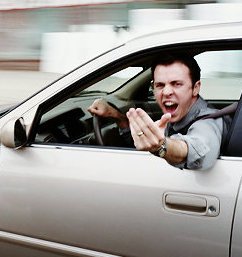ROAD RAGE
Road Rage
Road Rage is loss of emotional control while driving. Frustration and anger are key components in the creation of road rage. Being in control of the vehicle and one’s self while driving seems a self-evident goal to most drivers, however external factors can affect a driver’s control over their emotional state and result in loss of emotional control to a greater or lesser degree.
Aggressive driving can be described as “Driving under the influence of impaired emotions resulting in behavior that imposes risk on others”. Aggressive driving behavior is a driver’s attempt to respond to some type of situation or perceived problem using their available strategies. Unfortunately, these strategies are frequently ineffective or counter productive in resolving the issue and may ultimately result in the creation of greater problems for the driver and other road users.
Aggressive driving demonstrates hostility, lack of awareness, resistance to change, lack of emotional maturity, and cynicism towards authority. There are 2 types of aggressive drivers: Chronic and situational.
Chronic aggressive drivers have adopted a driving style, which is out of step with normal traffic flow and accepted norms of courteous driving behavior. They argue that their driving style is not aggressive at all, in fact it is the safest possible driving or they admit that it is aggressive and justify it based on various personal motives.
Situational aggressive drivers are responding to external pressures imposed on them as a result of schedules, traffic flows, the behavior of other drivers, environmental or other factors. Their otherwise safe responsible driving becomes aggressive under certain circumstances. These drivers may admit to the inappropriate nature of there behavior after the fact or alternatively justify it in a similar way to the chronic aggressive driver.
As a driver’s emotional state changes, their risk perception and tolerance also changes. Drivers with road rage tend to have an inappropriately high level of risk tolerance and therefore pose a risk to themselves as well as others on the road.
A stressed out driver may react with road rage, to frustration in traffic or what he perceives as hostile attitudes of other drivers. A study which looked at environmental factors that influence aggression showed that the following can cause rage in those with low frustration tolerance:
- Noise: While not provoking aggression, noise has been shown to influence the intensity of a pre-existing case of aggression. Thus a person prone to road rage, who is under stress or in an irritable mood, may be “set off” by someone honking behind him.
- Temperature: there was a direct relationship between temperature and driver aggression. The hotter it was the more aggressive the subjects became.
- Overcrowding: This is a subjective environmental factor. In experiments where all the subjects agreed to the fact that conditions were overcrowded, and especially in the case of traffic congestion, aggression may reach detrimental levels. Noise and heat may exert the most influence on motorists in a traffic congestion situation.
- Territoriality: individuals often view their vehicles as an extension of their home. At home, one sets standards for oneself that may be fine in the privacy of one’s home but would not be acceptable in public. The car seems to straddle the boundary between private space and public domain.

All of us have indulged in some form of aggressive driving at some or the other, subject to our moods. This includes
- Competitive driving, racing or showing off
- Excessive speed
- Prolonged, persistent, deliberate bad driving
- Wanton and furious driving
- Driving with disregard for road safety taking account of road weather and traffic conditions
- Deliberate acts of selfishness, impatience or aggressiveness causing inconvenience including:
o Cutting off, cutting in and slowing down.
o Changing lanes in a reckless manner or, weaving through traffic.
o Turning without signaling
o Cruising in the passing lane and not moving over
o Taking too long to turn or to get moving
o Yelling, insulting or gesturing at other drivers.
o Rushing or being impatient all the time.
o Tailgating and following too close
o Running a red light or speeding up to a yellow light.
The trigger for the aggressive driver is usually traffic congestion coupled with a schedule that is almost impossible to meet. As a result, the aggressive driver generally commits multiple violations in an attempt to make up time. For example, an aggressive driver who resorts to using a roadway shoulder to pass may startle other drivers and cause them to take an evasive action that results in more risk or even a crash. Meanwhile, the offending aggressive driver continues on his or her way, perhaps oblivious of what he or she has caused. Rush hour crashes, which are frequently caused by aggressive drivers, are a major contributor to congestion and 10 percent of these rush hour crashes contribute to a second crash.
Road rage, on the other hand, is a criminal offense. This occurs when a traffic incident escalates into a far more serious situation. Drivers with road rage:
- regularly experience hostile emotions and violent fantasies
- are unaware of their errors and style of driving
- resist change and lack the skills to change or to improve
- are unable to deal with their own emotions in traffic and lack the skills for self-control in traffic situations
- live in a conflictual or cynical mental state, accepting traffic regulations in an ideal sense, but rejecting them in an actual sense (e.g., speed limits, blood alcohol level, signaling regulations, parking violations, moving violations, required maintenance, seat belt use, child restraints, etc.)
